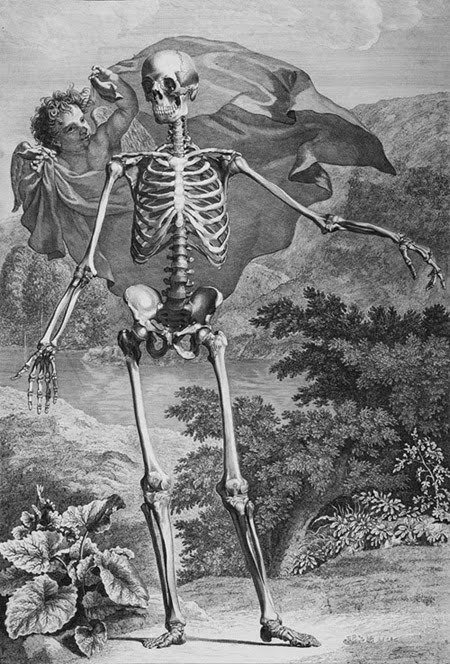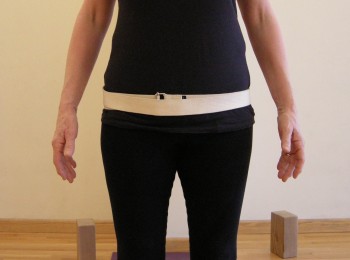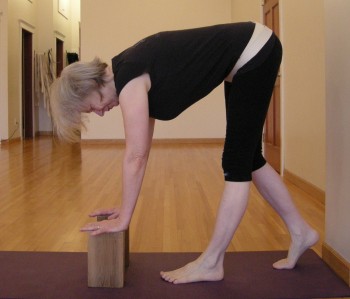In a forward bend with the legs parallel, the front thighs roll toward each other, the skin and muscles of the back thighs spread away from each other, and the sitting bones widen.
But while all this widening occurs, the tops of the thighbones, deep in the hip sockets, pull toward each other.
This should come as no surprise. There has to be an opposing action to all that spreading.
It’s an important action, too. Whenever the thighbones compact, they have the magical ability to lift the core body, all by themselves, with no hardening or gripping involved.
Once you learn the action, you can take it off your mat and into everyday life, lifting your core just a little, all the time. It’s a more effective strategy, I’d be willing to bet, than 100 crunches three times a week, with the rest of waking life conducted in a slouch of postural unconsciousness.
But as logical and important as it may be, there’s nothing easy about it.
That’s where the strap comes in.
Tied around the hollow of your hips, connecting with the greater trochanters – the points of the upper thigh bones that are most out to the side in Albinus’s elegant skeleton above – the strap focuses your awareness on the tops of your thighs, and gives you something to pull away from.
Do this Five-Minute Yoga Challenge without the strap, and you’ll still connect to the work of your feet and legs.
Add the strap and you’ll find a deeper understanding of how to compact your thighs, which is useful information for almost any pose.
There’s just one thing you have to know.
The magic of the thighs compacting can only happen when the buttocks are descending. If your buttocks are lifting, and your lower back is hollowed, you won’t get the same effect.
First, place the strap:
Stand up, and run your hand over your side hip. Notice the spot where you can press your fingers in most deeply, and feel the bone.
That’s your greater trochanter, the top of your thighbone. At its other end, angled slightly upward, is the ball of the ball and socket joint that makes up your hip.
Tie a strap around your hips with the strap on the greater trochanters. Make it firm but not tight. You’re looking for information, not a tourniquet.
Stand in mountain pose, with your feet hip distance apart.
Press your feet down, lift your kneecaps to firm your thighs, and press your top front thighs back.
Draw your buttocks down toward your ankles.
Then take your upper thighbones away from the strap, deeper into your hip sockets.
Notice how your lower abdomen tones and lifts.
Now choose the support for your hands.
You need enough height under your hands that you can press the backs of your thighs into the wall without being in Hamstring Hell.
It could be bricks, if your hamstrings are on the loose side.
If you’re at the far end of the tight hamstring spectrum, use the seat of a chair.
With your hands on the bricks or the chair seat, step back and bring your heels to the wall, hip distance apart.
Line up your outer feet with the outside edge of the mat.
Press your feet down. Lift your kneecaps.
Roll your front thighs towards each other. Spread your back thighs against the wall. Try to get as much of your back thigh touching the wall as you can.
Draw your buttocks toward your heels.
Pull the femur heads away from the belt, deeper into your hip sockets.
If the right action is there, you will feel your belly rise, relaxed and of its own accord, toward your spine.
Keeping your outer thighs drawn in and your front body long, come to your working place in forward bend, and release your head.
Stay for up to five minutes.
If that was your practice, you’ll find yourself refreshed from hanging your head in standing forward bend (Uttanasana) and with a new sense of liveliness in your legs. You can also enliven any time you spend standing in line, at the bank or the grocery store, by practicing the same action.
If you have time to play more, keep the strap on, and try stick pose, seated forward bend and a few standing poses.
You’ll find the strap improves your balance in reverse triangle – as long as you keep your buttocks drawing down.
Photo credits: Mary Balomenos.
If this was your kind of post, you might also like:
Use a strap around your hip crease to free your groins
Find your working place in hamstring stretches
Roll your feet on a tennis ball to loosen your hamstrings








Comments on this entry are closed.